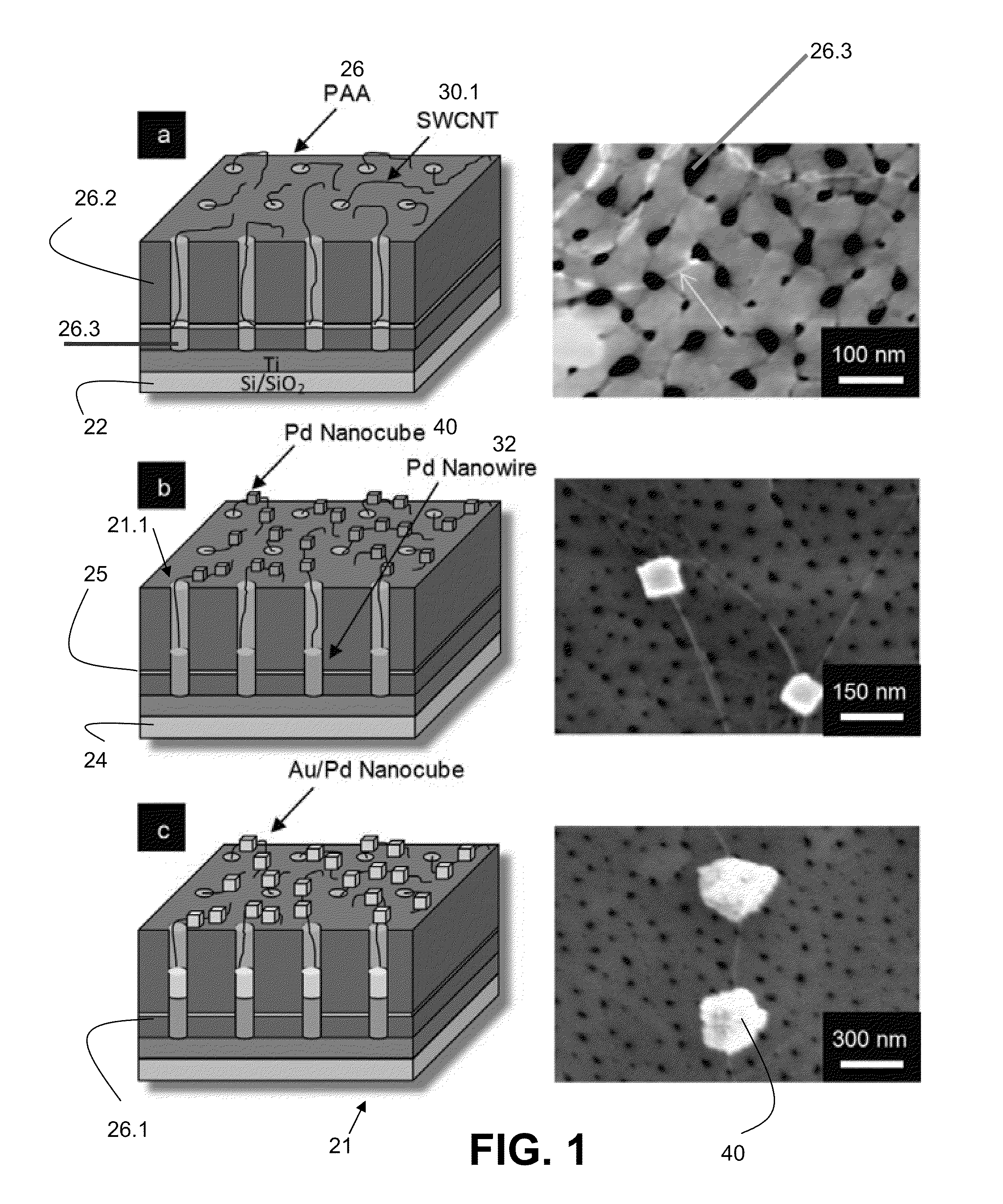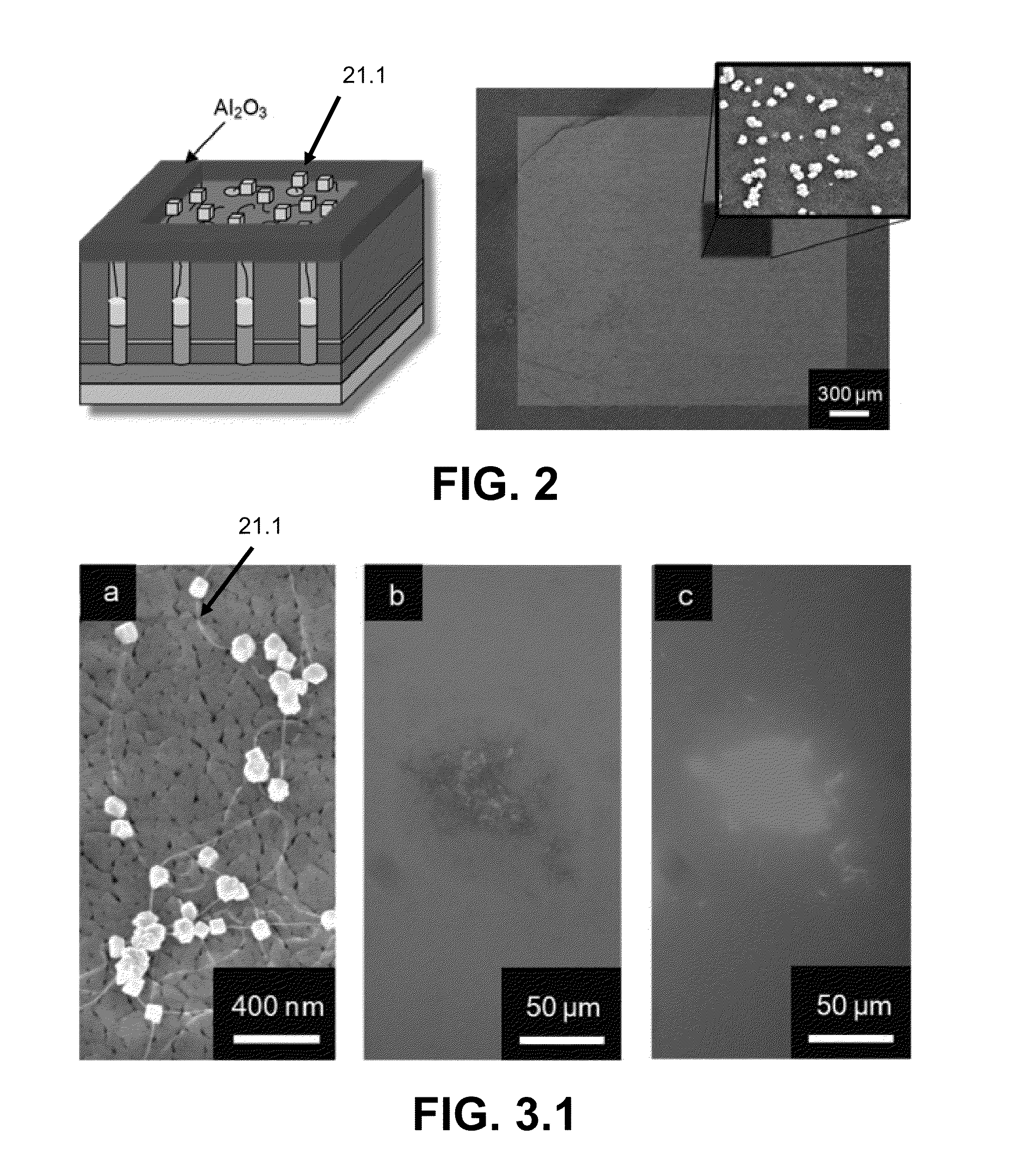Electrochemical biosensor
a biosensor and electrochemical technology, applied in the field of nanoparticle fabrication, can solve the problems of many home glucose monitoring systems that are inaccurate, serious complications, and many complications, and achieve good results in electrochemical glucose biosensing, facilitate enzyme immobilization, and enhance electrochemical performan
- Summary
- Abstract
- Description
- Claims
- Application Information
AI Technical Summary
Benefits of technology
Problems solved by technology
Method used
Image
Examples
first example
[0060]The construction of a biosensor 20 adapted and configured for detection of a substance 10 such as D-glucose according to one embodiment of the present invention is shown in FIGS. 1a, 1b, and 1c (including both a schematic and a photographic representation of one embodiment of the invention). FIG. 1 are tilted cross-sectional schematics with corresponding top view field emission scanning electron microscopy (FESEM) micrographs portraying sequential fabrication process steps: (a) SWCNTs 30 grown from the pores 26.3 of the PAA insulating and dielectric layer 26 via MPCVD (FESEM shows a SWCNT protruding from a pore and extending along the PAA surface), (b) electrodeposition of Pd to form Pd nanowires 32 in pores and Pd nanocubes 40 on SWCNTs (two such nanocubes are shown in corresponding FESEM), and (c) electrodeposition to coat the existing Pd nanocubes with a thin layer of Au.
[0061]One step in the fabrication of some nanocube-SWCNT biosensors in various embodiments involves the ...
second example
[0096]A metal film stack consisting of consecutive metal layers a conductive layer 124 of Ti (100 nm) and Al (400 nm) were thermally evaporated on an oxidized silicon wafer 222 [P Si (375 nm), SiO2 (100 nm)] via a thermal evaporator (Veeco 7760). The underlying Ti metal layer serves two roles: (1) supplies the bottom electrode electrical contact and (2) acts as an adhesion layer for subsequent metal deposition. The metalized substrate 222 was immersed in 0.3 M oxalic acid bath held at 5° C. and biased with 40 V versus a Pt gauze auxiliary electrode. This anodization process transforms the Al metal layers into the dielectric layer 226 (Al2O2), forming semi-ordered pores 226.3 (20-30 nm in diameter) known as porous anodic alumina (PAA) or anodic aluminum oxide (AAO). A portion of the substrate was not anodized, leaving an electrically conductive contact pad composed of the evaporated metals for subsequent electrodeposition and amperometric sensing.
[0097]To open the dielectric alumina...
third example
[0119]Glucose biosensors comprised of nanomaterials such as carbon nanotubes (CNTs) and metallic nanoparticles offer electrochemical performance that produce glucose sensing by detection of products resulting from the redox reaction of a substance 110 such as glucose. Various embodiments of the present invention provide for biosensor fabrication and biofunctionalization procedures that utilize CNTs electrochemically decorated with Pt nanospheres to sense glucose amperometrically with good sensitivity.
[0120]In one embodiment, CNTs 130 are grown in situ by microwave plasma chemical vapor deposition (MPCVD) and electrochemically decorated with Pt nanoparticles 140 (examples include nanospheres and nanocubes) to form a CNT / Pt nanoparticle composite biosensor 120. CNT electrodes are immobilized with fluorescently labeled bovine serum albumin (BSA) and analyzed with fluorescence microscopy to demonstrate their biocompatibility. The enzyme glucose 150 oxidase (GOx) is immobilized on the CN...
PUM
| Property | Measurement | Unit |
|---|---|---|
| length | aaaaa | aaaaa |
| length | aaaaa | aaaaa |
| diameter | aaaaa | aaaaa |
Abstract
Description
Claims
Application Information
 Login to View More
Login to View More - R&D
- Intellectual Property
- Life Sciences
- Materials
- Tech Scout
- Unparalleled Data Quality
- Higher Quality Content
- 60% Fewer Hallucinations
Browse by: Latest US Patents, China's latest patents, Technical Efficacy Thesaurus, Application Domain, Technology Topic, Popular Technical Reports.
© 2025 PatSnap. All rights reserved.Legal|Privacy policy|Modern Slavery Act Transparency Statement|Sitemap|About US| Contact US: help@patsnap.com



